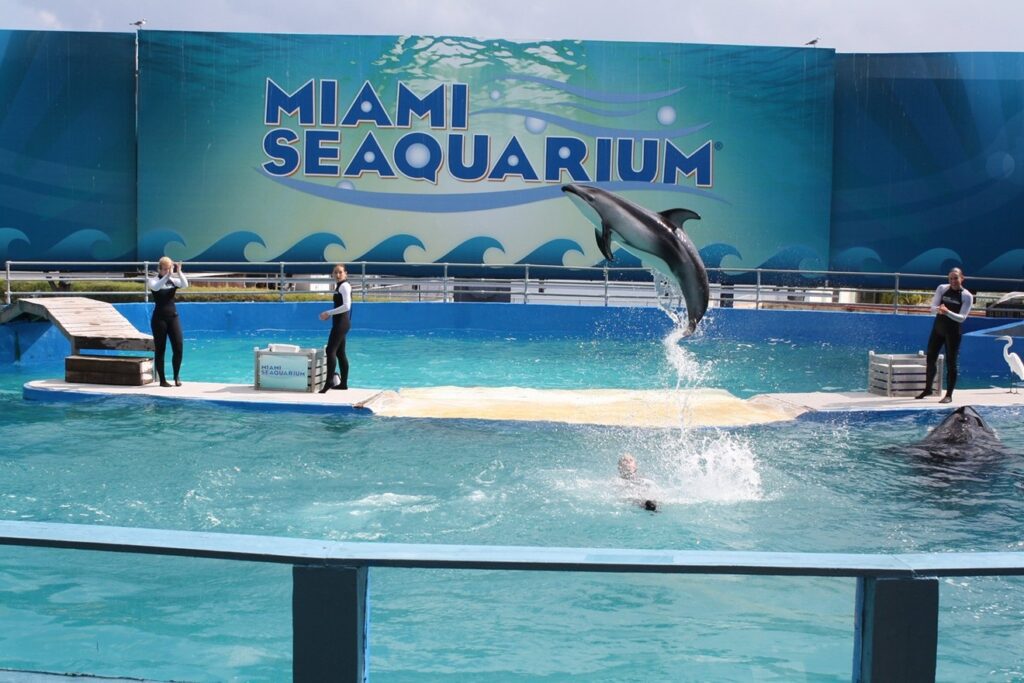“Yet Another Concrete Cell”: Activists Criticize Transport of Lolita the Whale’s Former Tankmate
Activists had sounded alarm bells over the dolphin’s future in the cramped and crumbling Miami tank.
By Alex Deluca
On September 25, 2023

In the wake of concerns that Li’i would languish in his Miami Seaquarium pool following the death of his longtime tankmate, Lolita the orca, the dolphin has been moved to a new home in Texas.
On Monday, the Miami Seaquarium announced that it had completed its transport of Li’i, a Pacific white-sided dolphin, to SeaWorld San Antonio. The dolphin spent decades living with Lolita before the famed killer whale’s death last month.
Activists had raised concerns over Li’i’s uncertain fate in the cramped and crumbling tank in Miami following Lolita’s death, with some advocating for his relocation to another marine park and others calling for his release to a seaside sanctuary.
“After the departure of Lolita, our animal care experts suggested his relocation to a habitat with other peers of his species, and our efforts to look for his well-being took him to SeaWorld in San Antonio,” Miami Seaquarium wrote in a statement. “Although we will very much miss him, we feel happy to know this is the best for him.”
Magdalena Rodriguez, a former Miami Seaquarium veterinarian, tells New Times that she’s confident Li’i, an elderly dolphin, will live out a better life in Texas surrounded by family members including his daughter Ohana, who was also confined at the Seaquarium before she was transferred to San Antonio years ago.
Rodriguez cared for Lolita, Li’i, and other marine mammals at the Seaquarium from the late 1990s until she was fired in 2021 after alleged fallout over her drawing attention to safety issues affecting animals at the park under its previous owner, Palace Entertainment.
The veterinarian says the last two years were likely stressful for Li’i as Lolita battled a persistent infection that led her health to deteriorate.
“Li’i should be in good company and much better hands,” Rodriguez says. “His daughter, Ohana, is a very personable dolphin that I am sure will socialize with him.”
Alongside veterinarians and a trainer, the 200-pound dolphin was chartered to the marine park in Texas on Sunday via a Boeing 767 in a container filled with cold water. He has since been reunited with two offspring, a former companion, and three other members of his species, according to the Miami Herald.
Li’i, who was captured off the coast of California in the 1980s, had been living at the Seaquarium since 1983.
On August 18, after more than five decades in captivity — and amid a headline-grabbing project to relocate her to an enclosure in her native Salish Sea — Lolita (also known as Tokitae or Toki) died at the estimated age of 57.
The day Lolita died, a Florida woman named Ashlyn Rittenhouse created a Change.org petition to relocate Li’i to the Shedd Aquarium in Chicago, which amassed more than 9,000 signatures.
Following the orca’s death, the poor state of her tank raised questions about whether her living conditions were to blame for her failing health. A former Seaquarium veterinarian, Jenna Wallace, told New Times that persistent water quality issues and a reduction in Lolita’s diet by more than 25 percent likely played a role in her initial deterioration.
In 2021, the stadium was closed off from public access and issued an unsafe-structure notice by Miami-Dade County, whose inspectors found that the facility was in a state of disrepair.
Li’i’s move has been celebrated by the Seaquarium and a subset of activists, but not everyone is pleased with the decision.
People for the Ethical Treatment of Animal’s executive vice president, Tracy Reiman, accused Miami Seaquarium of “violating” a promise to release Li’i to a seaside sanctuary, as some animal rights groups had demanded.
Following the orca’s death, the poor state of her tank raised questions about whether her living conditions were to blame for her failing health. A former Seaquarium veterinarian, Jenna Wallace, told New Times that persistent water quality issues and a reduction in Lolita’s diet by more than 25 percent likely played a role in her initial deterioration.
In 2021, the stadium was closed off from public access and issued an unsafe-structure notice by Miami-Dade County, whose inspectors found that the facility was in a state of disrepair.
Li’i’s move has been celebrated by the Seaquarium and a subset of activists, but not everyone is pleased with the decision.
People for the Ethical Treatment of Animal’s executive vice president, Tracy Reiman, accused Miami Seaquarium of “violating” a promise to release Li’i to a seaside sanctuary, as some animal rights groups had demanded.
The Seaquarium still exhibits bottlenose dolphins at live shows and sells tickets to “ride” them around a pool. For a $249 “Royal Swim,” visitors can “feel the thrill of riding on two dolphins in this intimate and unique experience,” the park advertises on its website.
SeaWorld San Antonio has its Pacific white-sided dolphins, including Ohana, perform at the Beluga Stadium, where they are trained to jump out of the water in unison and flip through the air.
Though SeaWorld ended its orca breeding program in 2016, the San Antonio park still has five captive orcas. The last orca born in SeaWorld captivity was Kyara, who died at the Texas facility three months after birth.
This piece was republished from the Miami New Times.